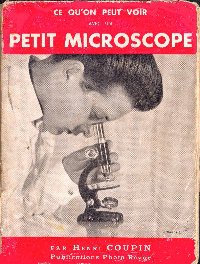
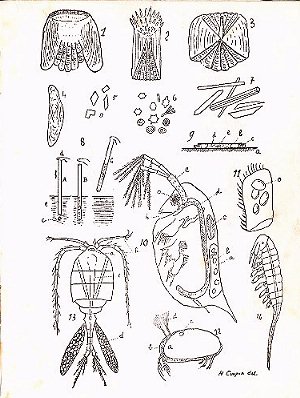

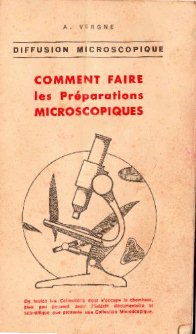
Title 'How to make microscopic preparations'.
|
or the good old days and nostalgia ! |
|
||||
| In the December 2001 issue of Micscape, I presented an introductory article for microscopy beginners and in which I deplored that microscopes were often sold without a practical booklet of instructions and examples of things to see. | |
| I don't know what the situation is in other countries, but in France, this kind of publication is rarely available nowadays. Maybe printed documents are not the best medium in this computer era? Probably in this domain, illustrations can play a major role to help identify microscopic organisms. | |
| But old books with pen and ink drawings are still a delight and may be more informative than 'raw' pictures taken by the most sophisticated camera. Indeed drawing allows many features to be shown of a single individual that you encountered only by observing many specimens: drawing is a 'synthetic seeing' and has the additional advantage of obliging the user to take the time to observe well. Here's an experiment: try drawing each object you observe and you'll probably discover some unnoticed details. I think that artists like Wim van Egmond won't contradict this affirmation! Alas, we are not so gifted to make such beautiful drawings as Wim (visit Wim's home page), and we resign ourselves to take pictures! |
 |
 |
I want to show you my first microscopy book; published ca. 1961/62. It looks in a poor state: I don't manhandle it but I have opened it many, many times and still do. I remember by rote some paragraphs! Its title was not ambitious : 'What you can see with a little microscope' but it is very well written by an enthusiastic microscopist. | ||
| Front cover of booklet and a page showing pen and ink drawings of fish scales and freshwater critters. | ||||
| Another object from the past! A picture of a reagents box from the same period. | ||||
 |
 |
The
outfit includes preservative, stain and mounting medium (Bouin's fixative,
acetic acid, hypochorite, safranin, glycerin gelly, sealing tar), some
small tools AND a little instruction booklet (enlargement at right hand
side) about preservation and staining - very well produced too.
Title 'How to make microscopic preparations'. |
||
| Many years ago
I bought another more 'serious' book with an old fashioned look. (I don't
know if I have an original edition or a reprint, but the yellowish paper
reinforces the first possibility). It was written in 1947(!) by a French
teacher who taught at the 'Collège of France', a prestigious institution
which still exists in Paris. It contains more than 2000 drawings and I
was astonished to find in this work some drawings which were in my first
modest booklet too! In the preface the author regretted (even in 1947!)
the general lack of interest in microscopy.
(Just a note which seems to confirm this fact: Intel's QX3TM microscope which is probably a wonderful way to bring together microscopy and the latest computer capabilities, is practically unobtainable in France ...) |
|
| In the 1940's some eminent teachers or researchers weren't afraid to write popular books and to explain science in simple words. This practice seem to be lost nowadays and may be one reason which has made science frightening to some people.... | |
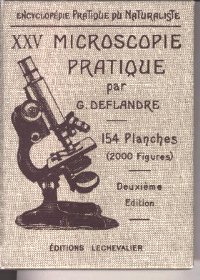 |
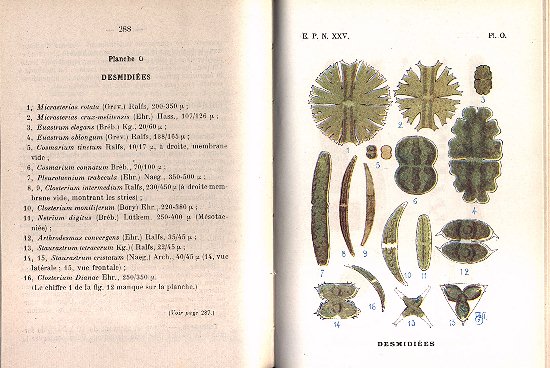 |
|
|
|
| But let's be constructive;
after all, it's probably one role of the monthly issues of Micscape
to make readers more aware of these books! In addition, some new French
microscopy clubs are becoming established on the Internet!
Maybe software on CD-ROMs with their interactive facilities could be the modern equivalent of these booklets? Why not one day include in every 'student' microscope kit, an interactive tutorial explaining microscope use and a large image data bank showing the many subjects which a microscope allows us to observe. Another thing missing nowadays, is a resource which contains all kinds of subjects you can see with your microscope: only thematic books are available and much more expensive. |
| I have tried (modestly!)
to make such a work for my children which I started 3 years ago by making
a CD-ROM (using Microsoft PowerPoint software to animate presentations..)
but it's always under construction! (Maybe because the microscopic word
is infinite ...? and because I am always adding new pictures!) I have chosen
this software, which is widely used in commercial animated presentations,
because a free viewer is available and links between slides are easy to
make. You can include vocal comments or your favourite music!
Below are some of the 100 slides of the slide show with more than 300 pictures: (Thumbnail images of the whole screen.) |
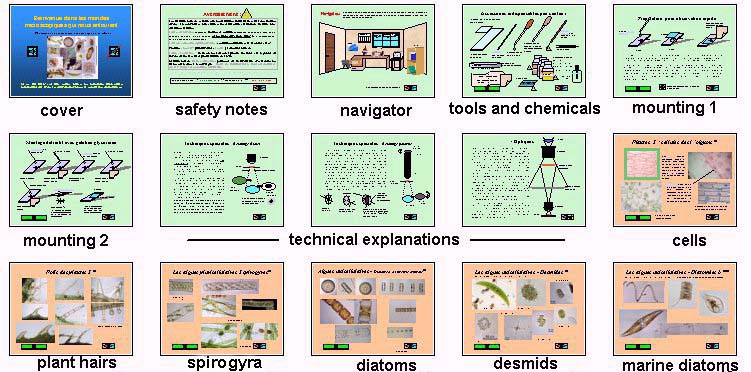 |
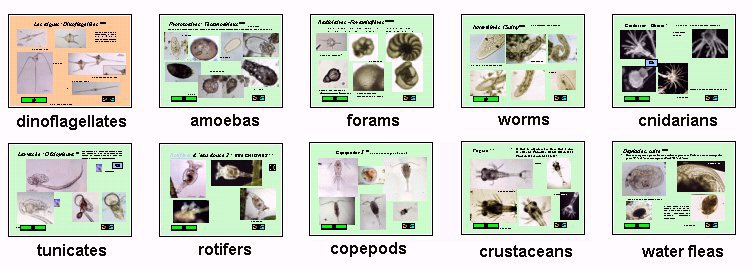 |
| The files have a total size
of around 30 MBytes. Slides are connected to about twenty little videos
in AVI format which are saved separately.
A catalogue of pictures on your computer with software to organise the albums, can be an alternative to making mounted slides: the subjects are more 'natural' with their true colors (preservatives lighten color with time). But mounted slides allow us to study at greater magnification and at a later time some details which can't be enlarged in album pictures. It's a large but creative job and in particular it obliges us to search for information, e.g. the species name ... and becomes a great means to improve our own knowledge..! Why don't you try too? If you don't have a CD-ROM writer, you can save these files on your hard disk and forget it for some months. On a winter rainy day for example, run the presentation. I think you will be surprised to see the work you've produced and seeing yourself cast as producer, director, cameraman, script writer, scientific consultant, special effects maker and, of course ... spectator! |
|
Microscopy
UK Front Page
WIDTH=1 All photographs © Jean-Marie Cavanihac 2002 Published in the July 2002 edition of Micscape Magazine. Please report any Web problems or offer general comments
to the Micscape
Editor,
Micscape is the on-line monthly magazine of the Microscopy
UK web
|